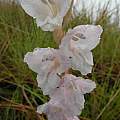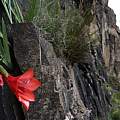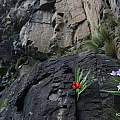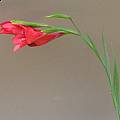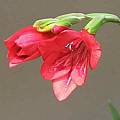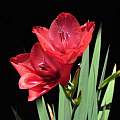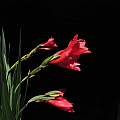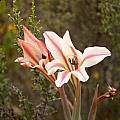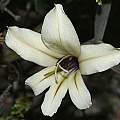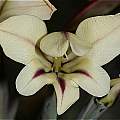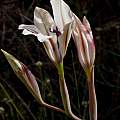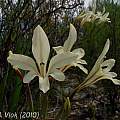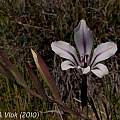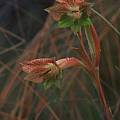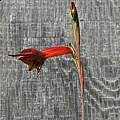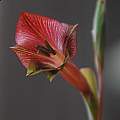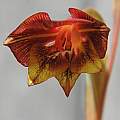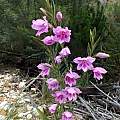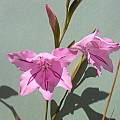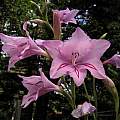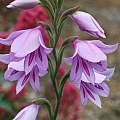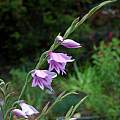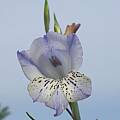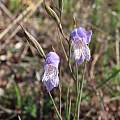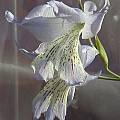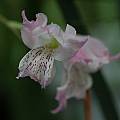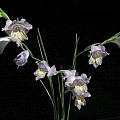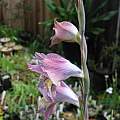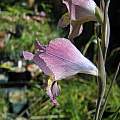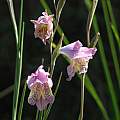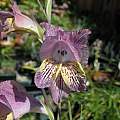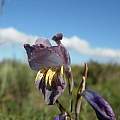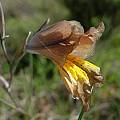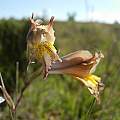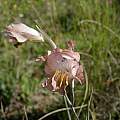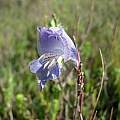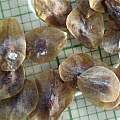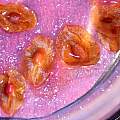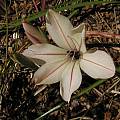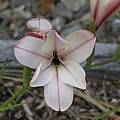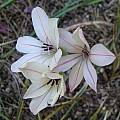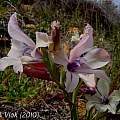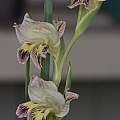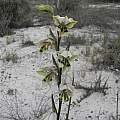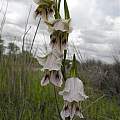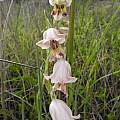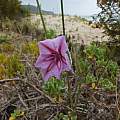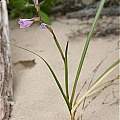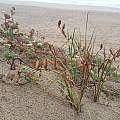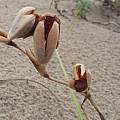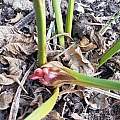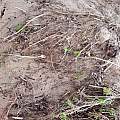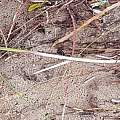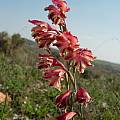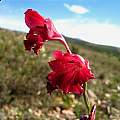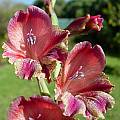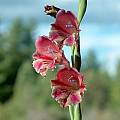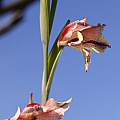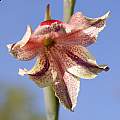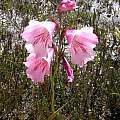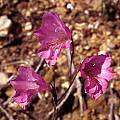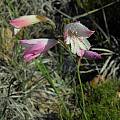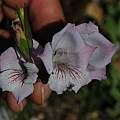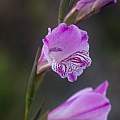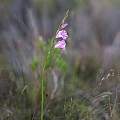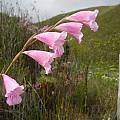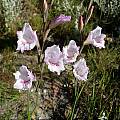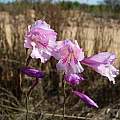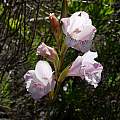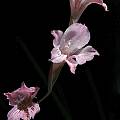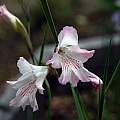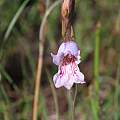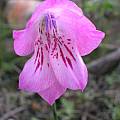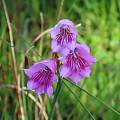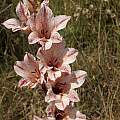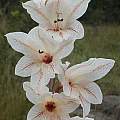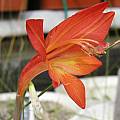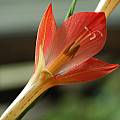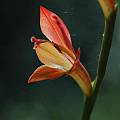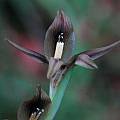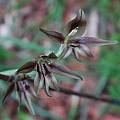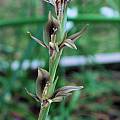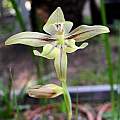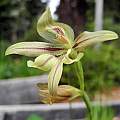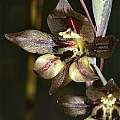There are about 163 Gladiolus species (with new ones being discovered) in the area south of the Tropic of Capricorn and including Botswana, Lesotho, Namibia, South Africa, Swaziland, and Mozambique. Some are found in winter rainfall areas and some in summer rainfall areas. For more information see Goldblatt and Manning, 1998. Southern African species from F-H are pictured on this page.
Gladiolus index - Southern African gladiolus A-B - Southern African gladiolus Ca - Southern African gladiolus Ce-E - Southern African gladiolus I-Me -Southern African gladiolus Mi-Pa - Southern African gladiolus Pe-R - Southern African gladiolus S-T - Southern African gladiolus U-Z - Gladiolus Hybrids - Miscellaneous gladiolus
Gladiolus ferrugineus Goldblatt & J.C.Manning grows in marshy grassland or well watered stony slopes in the summer rainfall area in eastern Southern Africa from the Northern Province to North Swaziland. Growing from 35-60 cm, it has 6-8 channeled leaves with the largest leaves twisted, and small white to pink short tubed flowers with rust colored bracts. The lower lateral tepals have cream to pale yellow blotches in the midline. There are two distinct forms. The form from the lower escarpment flowers in summer from late November to early February and has broader leaves and shorter tubes and the form from the upper escarpment flowers in autumn (March and April) and has narrower leaves with thickened margins and twisted blades and longer tubes. Photo from Rachel Saunders.
Gladiolus flanaganii Baker grows on the cliffs of the Drakensberg mountains in KwaZulu-Natal which form the border between Lesotho and South Africa. Height range: 35-60 cm. Long ago, plant collectors would risk death to see/collect these plants, thus it has gained the vernacular name "Suicide Lily". In milder climates maritime, it does well in a very well drained mix, full sun, and occasional watering. Water should be given often during hot spells. Keep the bulbs dry during their winter dormancy.
The photos below were taken by Callan Cohen of plants in habitat.
Photographs 1-2 taken by David Victor are of a wild collected material recently given to him by Danish friends. Photo 3-5 were taken by Nhu Nguyen who grew this in his Berkeley garden in a 1 gallon pot.
Gladiolus floribundus Jacq. grows on dry clay, sandy or limestone flats and slopes over a broad area of the winter rainfall Cape. It has white to cream or pinkish flowers with a dark median streak on all of the tepals and blooms in late spring. Height range: 20-45 cm. The first two photos taken by Cameron McMaster near Napier in the Overberg. Photos three, four, and five were taken by Andrew Harvie. Photo three was also taken in the Overberg in the De Hoop Nature Reserve. The last two were taken on a a rocky ridge top in the Swartberg Mountains.
Photos below from the book Plants of the Klein Karoo courtesy of Jan and Anne Lise Schutte-Vlok who write that this species grows up to 60 cm tall with broad grey green leaves. It can be confused with Gladiolus grandiflorus which has a shorter tube.
Gladiolus fourcadei (L.Bolus) Goldblatt & M.P.de Vos, syn. Homoglossum fourcadei (L.Bolus) N.E.Br, syn. Antholyza fourcadei L.Bolus, grows in a variety of soils in the Uniondale district of the Southern Cape. It has small, greenish yellow flowers with reddish veins and spots. Height range: 40-60 cm. This species is endangered, and reportedly now grows in only a single location threatened by overgrazing. The first photo was taken by Rod Saunders and the next three by Mary Sue Ittner.
Gladiolus geardii L.Bolus (syn. Gladiolus robustus Goldblatt) is a late spring to summer bloomer (November to January) found on moist sandstone slopes in the southeastern Cape where it gets limited rainfall year round with a bit less in summer. Growing from 80 to 150 cm high, it is described as having sword shaped leaves and pink flowers with darker markings on the lower tepals in a 6 to 10 flowered spike. The dorsal tepal is inclined. In cultivation in a Mediterranean climate, it is not dormant long. The first photo was taken by Rachel Saunders near Port Elizabeth where some very tall plants were in flower December 2013. One had 7 branches and 14 open flowers. The next two photos were taken by Bob Rutemoeller and the last three by Mary Sue Ittner.
Gladiolus gracilis Jacq. is very similar to Gladiolus caeruleus, but is a bit smaller, has fewer flowers (2 to 5 in a spike), is usually blue to grey, but occasionally pink or yellowish and has dark streaks (instead of spots) on the lower tepals. The lowermost tepal is usually longer in this species instead of mostly the same length as the others in G. caeruleus. It is found mostly on clay slopes (or granite) and blooms in winter. Height range: 30-60 cm. The first two photos were taken by Alan Horstmann. The third was taken by Mary Sue Ittner March 2004 of flowers grown from Silverhill Seed and the fourth in 2007 of more seed grown plants, but this time one with pink flowers. The last photo was taken by Bob Werra
The photos below were taken by Nhu Nguyen of a plant from Telos Rare Bulbs.
All of the pictures below were taken by Cameron McMaster near Napier in the Overberg and illustrate the different forms possible.
The photos taken by M. Gastil-Buhl show seeds from Silverhill Seed dry on a 1 mm grid, then wet.
Gladiolus grandiflorus Andrews grows on clay slopes in the renosterveld in areas with winter rainfall and some year round rainfall. Growing from 25 to 50 cm, it has sword shaped leaves with thickened margins and midrib and cream to greenish flowers in a two to nine flowered spike, sometimes with a darker median streak on lower or all the tepals. If flowers September to October. Photos 1-3 by Mary Sue Ittner of plants grown from seed that had creamy white flowers marked in red and flowered late April, early May each year in her Northern California garden. Photo 4 taken by Bob Rutemoeller at Bontebok National Park September 2003. The last photo below from the book Plants of the Klein Karoo courtesy of Jan and Anne Lise Schutte-Vlok.
Gladiolus griseus Goldblatt & J.C.Manning grows in calcareous sand and limestone soils right near the sea, all up the southwest coast to Saldanha. The total wild population of this species is estimated to be less than 250 plants. There are 3 to usually 6 to 15 small mauve to grey flowers with a yellow band across the upper third of the lower tepals edged in green and maroon. The dorsal tepal arches over the stamens and the lower narrow tepals are directed forward. The flowers are lightly fragrant and bee pollinated. This species is closely related to Gladiolus carinatus and sometimes difficult to distinguish from it. Bloom time is different as this species blooms earlier in winter (May to July). The flowers are also smaller and unbranched with the upper tepals arched forward and there are usually more flowers on a spike. Height range: 30-60 cm. The first two photos from Arnold Trachtenberg. The last three photos taken June 2011 by Rachel Saunders on the southwest Coast shows the variation in different plants.
Gladiolus gueinzii Kunze grows on coastal sand dunes at and above the high tide mark in the southern Cape where it occurs in both the winter and the summer rainfall areas. It produces small cormlets around the base of the buried corm like other species, but also produces a large glossy dark corm that is bouyant in the water and is dispersed to new areas by floating. Growing from 25 to 50 cm high, this species has four to eight mauve flowers with red-purple and white markings on the lower tepals. It flowers in late spring to summer. The first photo was taken by Rachel Saunders. The second photo was taken on the Otter Trail by Andrew Harvie.
Photos from Paul Sieben who comments: "The first photo reflects how close to the sea they grow and flourish. The base of the dune would have been cut by the past equinox spring tides. The second shows how big the pods are and how full they are relative to the flower. All the flowers I have seen have been very similar to the one that Andrew Harvie took (above), they hardly open. The abundance of seed and plants could be due to the closure of our beaches (in 2020) and a lengthy lockdown period here in SA, far less trampling of the dune area as this is at a popular access point".
Photo 3 shows how offset bulbs form around the base of the stem and result in clusters of plants.
In September 2023 "We have had extreme storm surges associated with Spring equinox tides which has stripped the coast of sand exposing the bulbs. This shows the white stem indicating that the bulbs are between 200 and 300 mm below the surface. In my experiences this is very deep for gladioli bulbs, it is possibly to prevent dehydration on the dunes. At least 70 % of the bulbs have been washed away in this one incident".
Gladiolus guthriei F.Bolus is a winter-growing species that occurs on rocky sandstone outcrops in the Western Cape. It incorporates plants formerly known as Gladiolus odoratus L.Bolus. It blooms in fall to early winter; April to June in its native range. Plants that will bloom send up a flowering stalk with very short leaf stubs on it. Plants not blooming in that year produce a long leathery leaf. The flowers generally have a pale yellow or straw base color, liberally decorated with mauve or dark magenta streaks and freckles. The result looks fairly dull from a distance, but the flowers reward close examination. They have a sweet scent. Height range: 40-70 cm. First four photos taken in Napier and Villiersdorp in the Overberg by Cameron McMaster. The fourth and fifth photos are of the Gladiolus odoratus form, blooming in December in California by Michael Mace.
Gladiolus hirsutus Jacq. has been described under many different names. For a long time it was confused with Gladiolus caryophyllaceus which has larger scented flowers and in the 1972 revision of this genus was named Gladiolus punctulatus but that name is no longer accepted as the correct name. It is widespread in the winter rainfall areas where it is found in a variety of habitats (sandy flats, mountain slopes, rocky outgroups), usually in sandstone or granite soils. It is pink to purple or white with darker streaking on the lower three tepals. The leaves are very hairy, hence the name. Height: 35-50 cm. The first two photos were taken by Bob Rutemoeller and Mary Sue Ittner in the southwestern Cape in September 2001 in an area that had burned the year before. The next two by Mary Sue Ittner were taken in August 2006 near the Du Toit Kloof mountain pass where we saw these blooming down the slope when we stopped to look at the view including a close-up of the latter when holding the flower helped to get the plant in focus because it was so windy. The fourth and fifth photos were taken in the Phillipskop Mountain Reserve near Stanford, by Christopher Whitehouse.
More habitat photos from Cameron McMaster from Hermanus and Napier in the Overberg.
Photos by Bob Werra, Mary Sue Ittner, and Alan Horstmann of garden plants.
Gladiolus hollandii L.Bolus grows on lower slopes of mountains and on granite outcrops, often in well drained gritty soil in light to moderate shade in the eastern southern African lowveld (Northern Province, Mozambique, Swaziland). Plants grow from 0.6-1.2 m and have a multi-flowered spike of 18 to 30 and sometimes more pale pink minutely dotted dark pink unscented flowers with a reddish median streak running the length of the tepals. Flowering time is mid February to April. Photos by Rachel Saunders.
Gladiolus huttonii (N.E.Br.) Goldblatt & M.P.de Vos syn Homoglossum huttonii N.E.Br is found on sandstone slopes in the southeastern Cape and flowers winter to spring. It has red to orange flowers with the lower tepals sometimes yellow. Height range: 30-60 cm. The first photo was taken by Bob Rutemoeller of a plant grown by Alan Horstmann. The next two pictures were taken by Mary Sue Ittner. Photos of many interesting hybrids of this species are found on the Gladiolus hybrids wiki page.
Gladiolus hyalinus Jacq. is a wide spread species in the winter-rainfall region where it is found from Namaqualand to the southwestern Cape and in a couple of places in the southern Cape and the Eastern Cape. In the Cape Flora region it is found in transitional fynbos and in Namaqualand on granite derived sand or clay. It flowers from winter into spring depending on the elevation. Flowers are light to reddish brown on a pale cream background. There are dark spots and streaks on the throat. Height range: 30-60 cm. The first five photos taken by Mary Sue Ittner who grew her plants from seed. Photos 4-5 were taken in a later year of flowers that look very different from the flowers of the one that bloomed in the past. The last photo was taken by Andrew Harvie on the R27, near Nieuwoudtville.
Gladiolus index - Southern African gladiolus A-B - Southern African gladiolus Ca - Southern African gladiolus Ce-E - Southern African gladiolus I-Me -Southern African gladiolus Mi-Pa - Southern African gladiolus Pe-R - Southern African gladiolus S-T - Southern African gladiolus U-Z - Gladiolus Hybrids - Miscellaneous gladiolus
